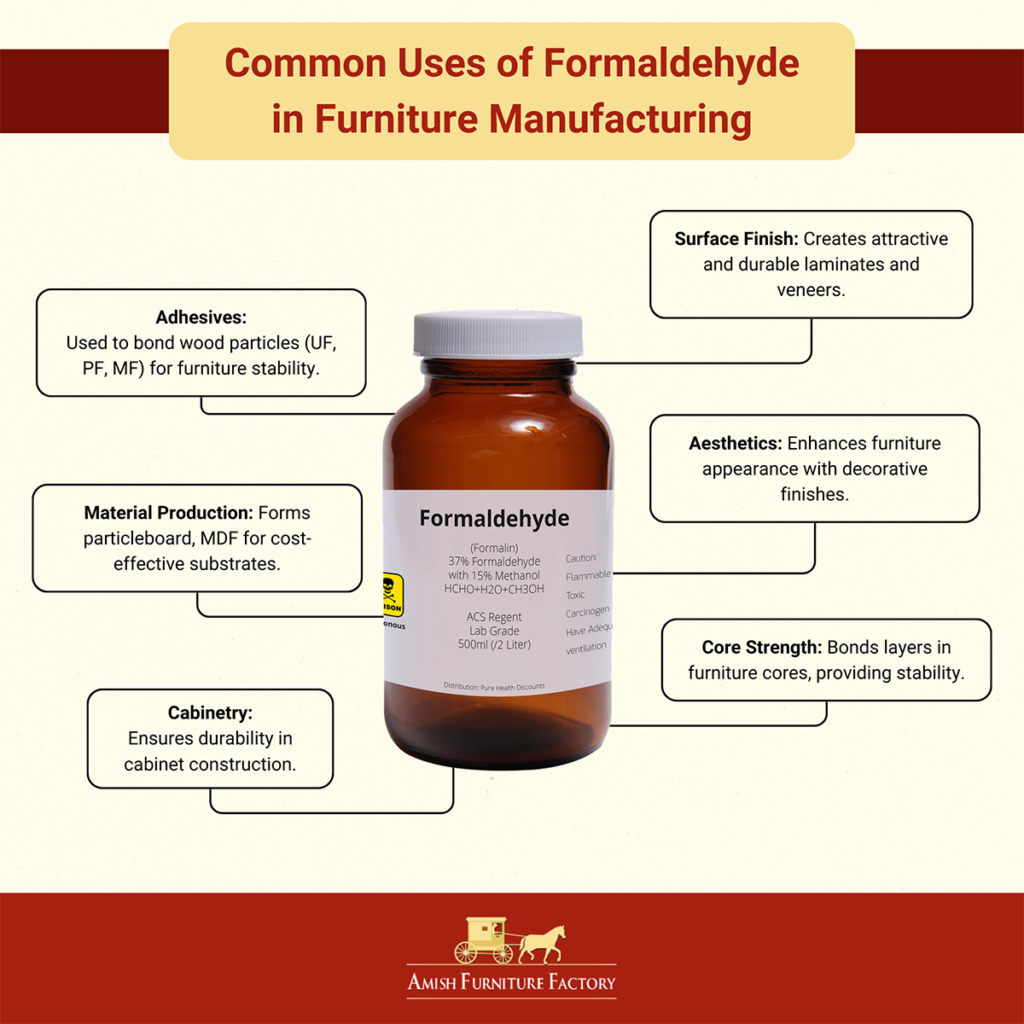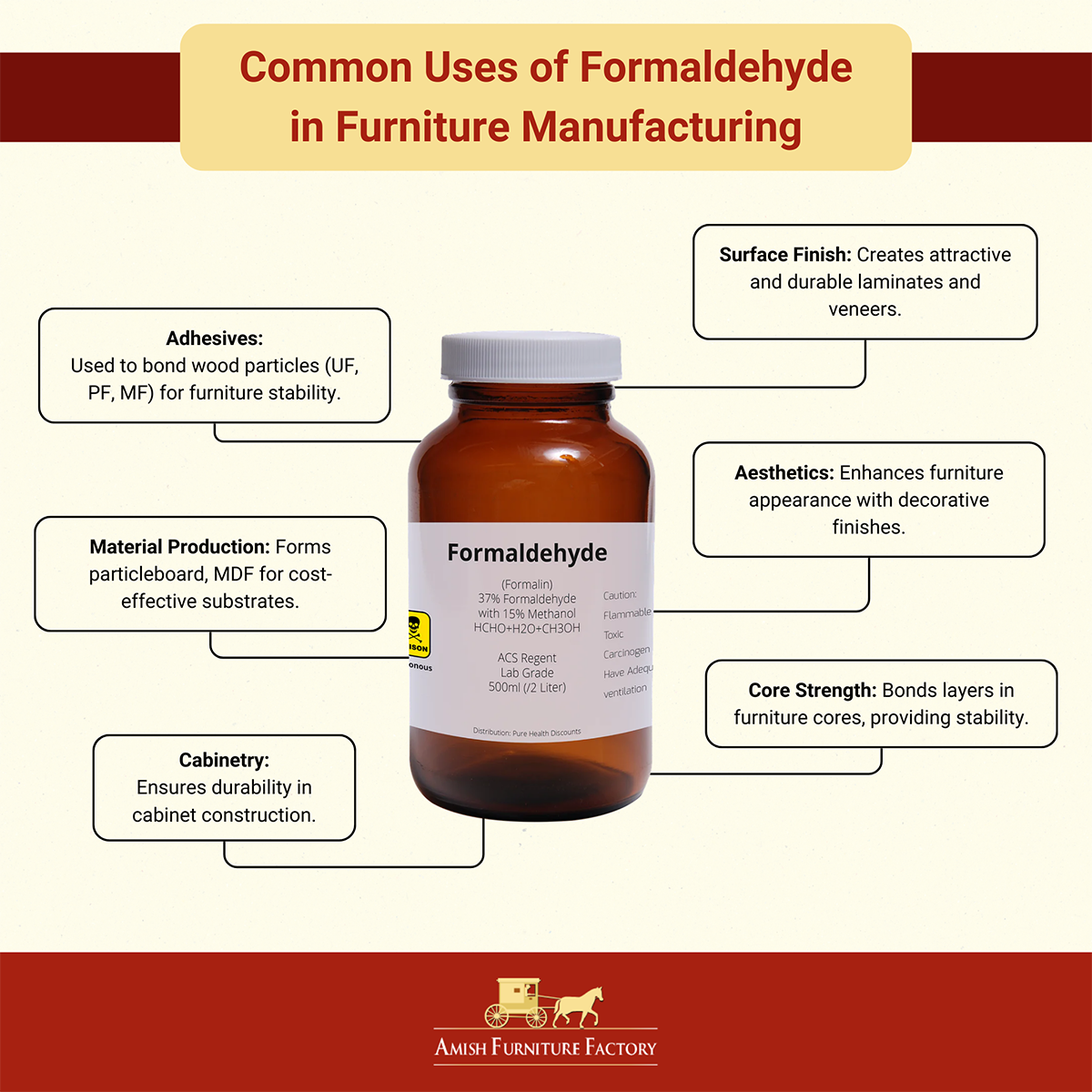
When you think about furnishing your home, the last thing you want is a side of chemicals with your cozy couch or charming coffee table. But here’s the thing: not all furniture is created equal, especially regarding the sneaky presence of harmful chemicals. So, does Amish furniture have formaldehyde?
Amish furniture typically offers lower formaldehyde risks due to traditional crafting with solid wood and natural finishes. This approach makes it a preferable, eco-conscious choice for those prioritizing healthier indoor air and less chemical exposure.
Let’s dive into the charming world of Amish furniture to discover if these handcrafted treasures are as healthy for our homes as they are beautiful, focusing on their use of formaldehyde compared to typical furniture today.
Formaldehyde in Furniture: A General Overview
Formaldehyde is a colorless, strong-smelling chemical compound with the chemical formula CH2O. It is a naturally occurring organic compound and is the simplest aldehyde.
Formaldehyde is highly soluble in water and readily evaporates into the air. It is commonly used in various industrial applications, including furniture manufacturing, due to its unique chemical properties.

Common Uses in Furniture Manufacturing
In furniture manufacturing, formaldehyde is primarily used in the form of formaldehyde-based adhesives and resins. These adhesives are crucial for binding wood particles or fibers together, creating durable and stable composite wood products used in constructing furniture items.
Adhesive for Composite Wood Products
Formaldehyde-based adhesives, like urea-formaldehyde (UF), phenol-formaldehyde (PF), and melamine-formaldehyde (MF), play a pivotal role in the production of composite wood products.
These adhesives bind wood particles or fibers together, creating sturdy and durable materials for furniture manufacturing. Particleboard, MDF, and plywood are examples of products extensively used in the construction of furniture.
Surface Finish
Formaldehyde-based resins can also be used in the production of laminates and veneers, which are applied as surface finishes on furniture items. These laminates provide an attractive, durable, and easy-to-clean surface for furniture pieces.
Particleboard and MDF Production
Formaldehyde-based adhesives are crucial in the creation of particleboard and MDF, which are commonly used materials in furniture manufacturing. These materials provide a stable and economical substrate for various furniture components.
Veneers and Laminates
Formaldehyde-based resins are used to manufacture veneers and laminates, which can be applied as decorative surface finishes on furniture items. These veneers and laminates enhance the aesthetic appeal of furniture and provide protection.
Cabinetry
Formaldehyde-based adhesives are used in the construction of cabinets and kitchen furniture, ensuring the durability and stability of these essential household items.
Furniture Core Materials
In the production of furniture cores, such as hollow doors, formaldehyde-based adhesives are used to bond the various layers of material, providing strength and stability to the final product.
The Health Impact of Formaldehyde
Formaldehyde, though beneficial in furniture making, is a health nemesis. Exposure to this chemical, especially in indoor environments, can irritate the eyes, nose, and throat.
In more severe cases, it has been linked to respiratory problems and even certain types of cancer. Think of it as an invisible risk factor, often overlooked but potentially harmful over time.

A pivotal study sheds light on the tangible impacts of formaldehyde exposure. It found that children in homes with formaldehyde levels of 60–120 ppb faced greater prevalence rates of asthma and chronic bronchitis, especially when coupled with exposure to environmental tobacco smoke.
This research underlines the significant health risks associated with even moderate levels of formaldehyde in our living spaces.
Understanding Exposure Levels
The risk associated with formaldehyde largely depends on the concentration and duration of exposure. Low levels of formaldehyde are commonly found in many households, but the concern arises with prolonged exposure to higher concentrations.
The above study observed the adverse effects on children’s respiratory health. Children exposed to formaldehyde at levels as low as 60 ppb were linked to a 22% decrease in peak expiratory flow rates (PEFR) compared to those in non-exposed environments.
This finding highlights the insidious nature of formaldehyde exposure, especially in vulnerable populations.
Sensitive Groups and Formaldehyde
Some individuals are more sensitive to formaldehyde than others – young children, older people, and people with pre-existing respiratory conditions. For these groups, even lower levels of formaldehyde can trigger symptoms, making it crucial to consider furniture choices in homes with vulnerable residents.
Asthmatic children exposed to lower concentrations of formaldehyde exhibited more severe effects than their healthier peers, emphasizing the need for heightened vigilance in homes with asthmatic individuals.
Navigating Safety Standards
Safety standards and regulations are in place to limit formaldehyde emissions from furniture to protect consumers. These standards act as a safety net, ensuring that products in the market don’t cross the line regarding emission levels.
Adhering to these standards is essential for minimizing the risk of formaldehyde exposure, especially in settings like homes and schools where children and other sensitive groups spend significant amounts of time.
Amish Furniture Crafting Techniques and Formaldehyde Emissions
When we think of Amish furniture, we often picture classic, beautifully crafted pieces that seem to defy time. But what sets Amish furniture apart is the unique crafting techniques they use.
Here’s an overview of how Amish furniture is different from other furniture items made using conventional methods:

Emphasis on Handcrafting
At the heart of Amish furniture making is the emphasis on handcrafting. Each piece is built by skilled craftsmen using traditional methods passed down through generations.
This approach ensures attention to detail and craftsmanship that’s hard to find in mass-produced furniture. It’s not just about making furniture but creating heirlooms that last for generations.
Use of Solid Wood
One of the most distinctive features of Amish furniture is the use of solid wood. This technique contrasts sharply with the common use of veneers or engineered wood in commercial furniture.
Solid wood enhances the aesthetic appeal and contributes to the furniture’s strength and longevity. The Amish typically use hardwoods like oak, cherry, and maple, known for their durability and beautiful grain patterns.
Traditional Joinery Techniques
Amish furniture is renowned for using traditional joinery techniques, such as dovetail or mortise-and-tenon joints. These methods, which have been used for centuries, create connections between pieces of wood that are incredibly strong and can withstand years of use.
Unlike modern furniture that often relies on adhesives or mechanical fasteners, Amish furniture is built to last using these time-tested techniques.
Natural Finishes and Low VOCs
In line with their commitment to natural materials and sustainability, Amish artisans typically use finishes that are low in volatile organic compounds (VOCs).
These natural finishes not only enhance the wood’s beauty but also minimize the release of harmful chemicals into the environment. It’s a win-win for the furniture’s quality and the consumers’ health.
Customization and Personal Touch
Finally, Amish furniture stands out for its customization options. Since each piece is made by hand, customers can often customize their furniture according to their specific preferences in size, wood type, finish, and design.
This personal touch adds value and connection between the furniture and its owner.
Amish Approach to Materials
Amish furniture is synonymous with quality and sustainability, primarily due to their choice of materials. Solid wood is the cornerstone of their craftsmanship, which inherently emits lower levels of volatile organic compounds (VOCs) than engineered woods.
Solid woods like oak, cherry, and maple are preferred for their durability and natural beauty. Amish furniture significantly reduces potential formaldehyde exposure by avoiding engineered wood, which often contains formaldehyde in adhesives.
If you’re curious, you might want to read on Amish furniture vs Chinese-manufactured furniture.
Natural Finishing Techniques
A key aspect of Amish furniture making is their finishing process. Instead of using synthetic finishes that may contain high levels of VOCs, including formaldehyde, Amish furniture makers often opt for natural finishes.
A common practice is hand-rubbing with linseed oil, which provides a beautiful finish and minimizes the introduction of harmful chemicals. This approach aligns with their commitment to natural, eco-friendly furniture-making practices.
Traditional Crafting Methods
The traditional methods employed by Amish craftsmen further distance their products from formaldehyde use. Instead of relying on modern adhesives, which often contain formaldehyde, they use time-tested joinery techniques to assemble their furniture.
These methods, such as dovetail or mortise-and-tenon joints, rely on the skillful manipulation of wood to create strong, lasting bonds without chemical additives.
Lower Risk of VOC Emissions
Given their use of solid wood, natural finishes, and traditional crafting methods, Amish furniture presents a lower risk of VOC emissions, including formaldehyde. This makes it an attractive option for those seeking furniture that is durable, aesthetically pleasing, and healthier for indoor environments.
Choosing Safe and Sustainable Furniture
We often prioritize style and comfort in the quest for the perfect furniture. But what about safety and sustainability? Selecting furniture that’s kind to our health and the environment requires more thought.
Understanding Material Safety
The first step in choosing safe furniture is understanding the materials used. Pick furniture made from solid wood rather than engineered wood products like particle board or MDF, which often contain higher levels of formaldehyde due to the adhesives used in their production.
Natural materials minimize exposure to harmful chemicals and are more durable and long-lasting.
Look for Certifications
Certifications can guide you in finding furniture that meets health and environmental standards. Look for labels like GREENGUARD, which certifies products for low chemical emissions, or the Forest Stewardship Council (FSC) certification, indicating that the wood has been sourced from responsibly managed forests.
Consider the Furniture’s Origin
The origin of the furniture is another essential aspect to consider. Furniture made locally or within your region often has a lesser carbon footprint due to reduced transportation distances.
Additionally, local craftsmanship often means higher quality and a smaller ecological impact, as many small-scale manufacturers adhere to more sustainable practices.
Eco-friendly Finishes and Paints
Pay attention to the finishes and paints used on furniture. Opt for products with natural oils and waxes or water-based, low-VOC paints and finishes.
These options are better for the environment and reduce the off-gassing of harmful chemicals in your home.
On Certifications and Standards
Certifications and standards are essential quality, safety, and environmental impact indicators. When considering Amish furniture, it’s necessary to understand how these pieces fit into the broader picture of furniture certifications.
Formaldehyde and VOC Emissions Standards
Standard certifications like CARB (California Air Resources Board) for formaldehyde and GREENGUARD for low VOC (Volatile Organic Compounds) emissions are crucial for many consumers. These certifications ensure that furniture meets specific health and environmental safety standards.
While traditional Amish furniture-making practices typically involve solid wood and natural finishes, suggesting a lower likelihood of high formaldehyde or VOC emissions, not all Amish furniture may be formally certified.
Verifying Amish Furniture Certifications
Potential buyers must inquire about certifications with Amish furniture makers or sellers. Due to the diverse nature of Amish furniture makers, certification adherence can vary.
Some Amish craftsmen might not seek these certifications due to the small scale of their operations or the traditional nature of their crafting techniques. However, this does not necessarily mean their furniture is of lower quality or safety.
Eco-Friendly and Sustainable Practices
Sustainability is another crucial aspect of furniture certifications, with standards like the Forest Stewardship Council (FSC) indicating responsibly sourced wood. While Amish furniture is often praised for its sustainable and eco-friendly practices, formal certification may not always exist.
As with formaldehyde and VOC emissions standards, direct communication with sellers can clarify the sustainable practices and materials used.
The Role of the Consumer
As a consumer, being informed and asking the right questions is crucial. Understanding the potential presence or absence of certifications in Amish furniture will help you make choices aligned with your values and needs.
Whether seeking furniture with formal certifications or relying on Amish craftsmanship’s traditional, artisanal reputation, make an informed decision based on your preferences and all the available information.
Navigating Formaldehyde Concerns in Amish Furniture
While the world grapples with balancing modern living and health concerns, Amish furniture presents a compelling choice. It refers to a simpler time when natural materials and traditional craftsmanship spoke of durability and safety.
By choosing Amish furniture, you’re not just selecting a piece for your home; you’re embracing a legacy of craftsmanship that naturally aligns with a healthier living environment, free from the worries of harmful chemicals like formaldehyde.

